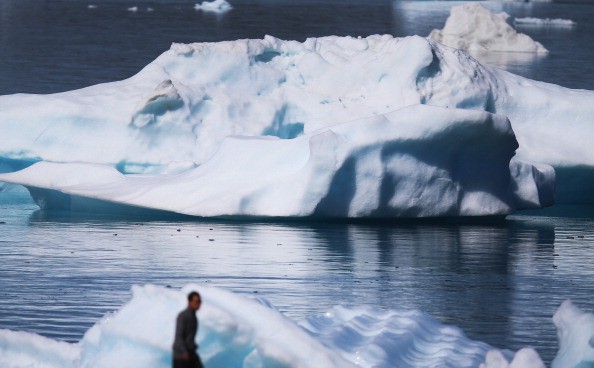What Happens When Earthquakes Strike Glaciers?
| KJ Belonio | | Jun 26, 2015 06:02 PM EDT |
(Photo : Getty Images/Joe Raedle) In a recent study published in the journal Science, researchers explained that glacial earthquakes can cause a seismic event detectable across the Earth.
What do you think happens when earthquakes strike glaciers? In a recent study published in the journal Science, researchers explained that glacial earthquakes can cause a seismic event detectable across the Earth.
Like Us on Facebook
Glacial earthquakes have been increasingly documented in recent years. In Greenland, these mysterious quakes have increased seven-fold in the past 20 years. Now, scientists believe they have figured out the dramatic geophysical effect brought by the rumbling phenomenon after large chunks of ice broke off of a glacier and made a huge splash into the cold waters.
In the recent study, a team of scientists from several institutions explained how the loss of Greenland's ice can produce glacial earthquakes. According to Washington Post, when vast icebergs snap off at the end of tidal glaciers, they tumble into the ocean and jam the glaciers themselves backwards.
Since the backward movement and subsequent change in water pressure generate glacial earthquakes, a seismic event can trigger massive tsunami waves and thunderous rumbling, Live Science reported.
"Imagine that you could go and just push on the front of the glacier with your thumb, really hard, so hard that you could reverse the direction that the front of the glacier is moving," Columbia University Earth Science professor and study co-author Meredith Nettles told NPR. "And then you let it go. And that backward and then forward motion is actually recorded in the GPS data from the front of the glacier."
In 2013, scientists conducted their research on Greenland's Helheim Glacier for 55 days. By using cameras, GPS sensors and the global seismographic network, they were able to capture the details of 10 large-scale calving event, Nature World News revealed. The researchers have learned how the icebergs dropped off from the glacier and temporarily reversed its course, causing glacial earthquakes that measure about magnitude 5 on the Richter Scale.
During the sinking, two massive forces are generated. The first one occured as the tumbling top of the iceberg pushes against the glacier, and actually drove the sheet of ice backwards and inland. During the earthquakes, researchers said the region near the calving front shows a dramatic reversal of flow, moving up a glacier for several minutes in spite of simultaneously moving downward.
The second force, on the other hand, was when iceberg separated from the glacier, opening a gap for water to rush into. This resulted in an upward force acting on the solid Earth.
Glacial earthquake induced by calving is such an important component of the mass loss in both Greenland and Antarctica. While it can generate huge tsunamis, researchers said that understanding how calving actually works is playing a vital role in linking the phenomenon to the anthropogenic climate change.
Meanwhile, apart from the drama of tsunamis and glacial earthquakes, the most fundamental effect contributes to rising seas, as it continues to happen over and over again.
Tagsglaciers, earthquakes, Science, Glacial Quake
©2015 Chinatopix All rights reserved. Do not reproduce without permission
EDITOR'S PICKS
-

Did the Trump administration just announce plans for a trade war with ‘hostile’ China and Russia?
-

US Senate passes Taiwan travel bill slammed by China
-

As Yan Sihong’s family grieves, here are other Chinese students who went missing abroad. Some have never been found
-

Beijing blasts Western critics who ‘smear China’ with the term sharp power
-

China Envoy Seeks to Defuse Tensions With U.S. as a Trade War Brews
-

Singapore's Deputy PM Provides Bitcoin Vote of Confidence Amid China's Blanket Bans
-

China warns investors over risks in overseas virtual currency trading
-

Chinese government most trustworthy: survey
-

Kashima Antlers On Course For Back-To-Back Titles
MOST POPULAR
LATEST NEWS
Zhou Yongkang: China's Former Security Chief Sentenced to Life in Prison

China's former Chief of the Ministry of Public Security, Zhou Yongkang, has been given a life sentence after he was found guilty of abusing his office, bribery and deliberately ... Full Article
TRENDING STORY

China Pork Prices Expected to Stabilize As The Supplies Recover

Elephone P9000 Smartphone is now on Sale on Amazon India

There's a Big Chance Cliffhangers Won't Still Be Resolved When Grey's Anatomy Season 13 Returns

Supreme Court Ruled on Samsung vs Apple Dispute for Patent Infringement

Microsoft Surface Pro 5 Rumors and Release Date: What is the Latest?










